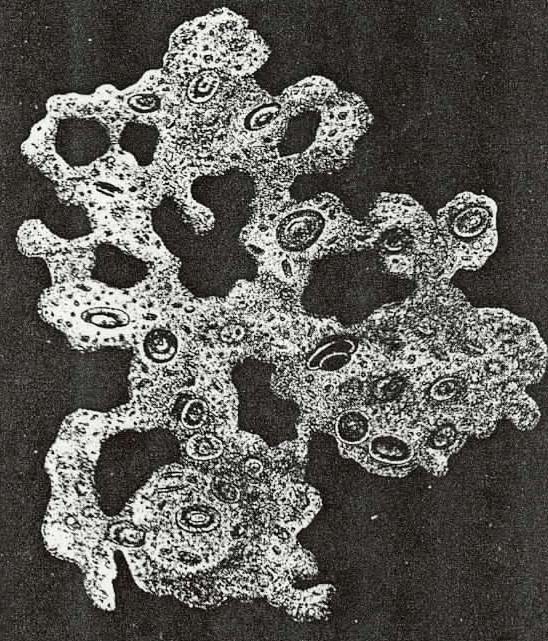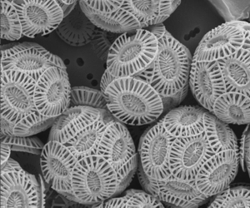 |
| Bathybius |
I have found a treasure trove of old science papers – every paper every published in the American Naturalist, from 1867 to today. These papers are fascinating, giving me some much-desired insight into the state of biology shortly after the publication of the Origin of Species.
Today I wanted to share a story that is partially revealed in the 1870 paper, ‘What is Bathybius?’ by W.C. Williams.
During the 1800s there was a great deal of speculation about the cause of life. There seemed to be something different in kind between a rock and a cell. Crystals
Williams remarks that, no matter how good we get in the lab at mimicking the organization of life, we can never seem to find that spark to give it life. There is clearly something, some force, that distinguishes the living from the dead, that separates a stone from a tree. Of this vital force he says, ‘I claim to be as philosophical, and to be acting in as truly a scientific spirit, when I recognize its existence as when I speak of a magnetic force or of a force of gravitation.’
At this period in time there was a great deal of fascination with something called protoplasm – a gelatinous substance that seemed to be found in the early stages of all sorts of life, from the yolk of an egg to the composition of a protozoan. This protoplasm, it seemed, was the source of this vital force, and yet, even though its composition of oxygen, hydrogen and carbon was known, and could be replicated in the lab, no amount of synthetic protoplasm ever contained the properties of life.
Williams likens the origins of life to the pursuit of a rainbow – we can see where it touches down, but the closer we get to its source, the more elusive it becomes.
Williams says that, even if we were to find the first cell from which all life began, still we would be at a loss to account for the emergence of the vital force. Pay careful attention to what he says next:
‘Except in a few obscure cases, too ill-understood to be made the basis of a grave argument, protoplasm can always be traced, directly or indirectly, to some preexisting form of protoplasm. We nowhere discover any power which, without the intervention of some already living agent, can convert inorganic matter into living matter. If we could even trace back the history of protoplasm, until we reached one of Mr. Darwin's primeval germs, our philosophy would still leave the first of these living azotized combinations unaccounted for. Since, then, scientific experience affords no proof that life is nothing more than a function of material combinations, acted upon by physical forces, we are justified in the recognition of a vital principle, emanating primarily from a living Creator, but which, once created, appears capable of self-perpetuation to the end of time.’
Keep in mind that this is not a religious text; this is a fully scientific text, in a journal that published during this time period writings by T.H. Huxley, Asa Gray, Joseph Hooker, Louis Agassiz, Alfred Russell Wallace, James Dawson and the like. These are big name scientists in the 1800s, and yet here is a man essentially claiming that the origins of life itself will never be explicable apart from a Creator!
This is, to be sure, an important insight into the relationship between science and religion in the 1800s.
Bathybius
All of this is really just the preliminary to the main topic – what, exactly, is Bathybius? This paper is amazing because it highlights a little-known (outside of Creationist circles) story of when one of the world’s pre-eminent evolutionists and atheists made an embarrassing mistake. Only this paper was written before anyone knew of the mistake.
Thomas Henry Huxley was often known as Darwin Atlantic with samples of ocean sediments, which he gave to Huxley. Upon examination, Huxley discovered a protoplasmic entity that was spread throughout the sediments. Within this protoplasm were little calcium carbonate shells, of a singularly beautiful design, which he called coccoliths. The protoplasm itself he called Bathybius, and declared it to be the lowest form of life ever discovered – the protoplasm from which all other life evolved. It seemed to be everywhere on the ocean floor, and the coccoliths that it apparently produced were soon discovered to make up the majority of the ancient chalk deposits.
Says Williams, ‘There can be no question that Bathybius is the lowest of those known Protozoa…’ Huxley even had a taxonomic category for it: Monera.
Ernst Haeckel, another pre-eminent biologist, agreed with Huxley that Bathybius was the missing link between organic matter and inorganic matter. Williams, in this paper, agrees, but only up to a point – it may be the originator of all living things, but it itself required the vital force from God in order to give it life.
This paper was published in 1870; in 1872 the Challenger expedition failed to find any Bathybius on the ocean bottom. Shortly thereafter it was discovered that Bathybius was formed if the ocean sediments were preserved in alcohol; a letter to Huxley confirmed that all of his samples had been preserved in such a manner. Instead of being a precursor to life, Bathybius was merely a chemical reaction that occurred between calcium sulphate in the seawater and alcohol! It was not alive at all.
Lesson: even arrogant atheistic scientists, who wish to expunge all religious myth from science, are capable of creating myths of their own.
The damage had been done – the public had believed in Bathybius. In 1879 Huxley had to shamefacedly admit (but to his credit) that Bathybius was a product of his overeager mind. But myths do not die so easily; Haeckel disagreed with Huxley, and continued to write about Bathybius for another four years. Apparently Haeckel even drew pictures of the evolution of Bathybius, which he claimed were from observation. But this would not be the last time Haeckel was accused of fraud.
The upside to this story is that the coccoliths found within Bathybius were a newly-discovered form of life, which just happened to get suspended within the chemical reaction that was Bathybius. I will leave you with a picture of this beautiful microscopic life form. It is far from being life’s precursor, but is interesting nonetheless.
Where are we now, one hundred and forty one years after the publication of this paper? Have we yet discovered what separates life from non-life? The answer is, not quite. One of the biggest advances has been the discovery of self-replicating molecules, chemicals that can produce more of themselves. A form of natural selection can even occur among these molecules, as copy errors produce some variants that can replicate faster than others. Although there is a great deal of plausible speculation that it is from molecules like these that we get DNA, we do not yet have a good working model for the true origin of life. Bathybius, though, was a nice try.
 |
| Coccolithophores |
No comments:
Post a Comment